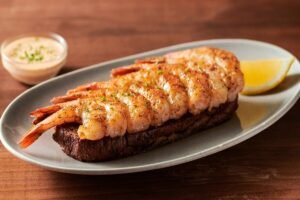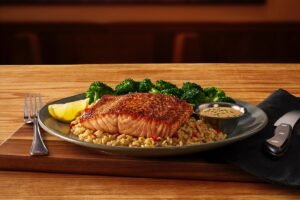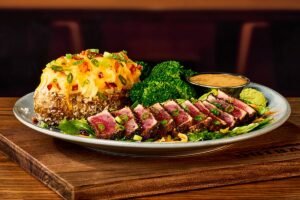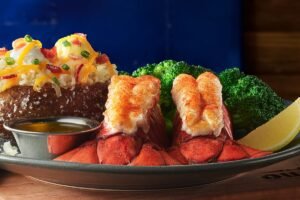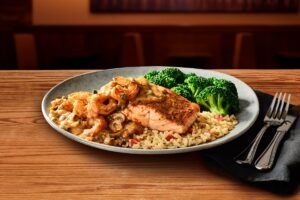Nobody walks into Outback Steakhouse thinking “great seafood spot,” yet their seafood program quietly rivals dedicated fish houses in both quality and execution. This Australian-themed steakhouse in the middle of America somehow pulls off serving fresh Atlantic salmon, cold-water lobster tails, and jumbo shrimp that would make coastal restaurants jealous.
The seafood menu at Outback tells an interesting story about American dining evolution. When Outback launched in 1988, seafood was an afterthought – a couple of shrimp options for the non-beef eater. Today, seafood represents 18% of total entrée sales, with some locations moving more lobster tails than sirloin steaks. This transformation didn’t happen by accident but through deliberate sourcing improvements, preparation refinements, and understanding that modern diners expect oceanworthy options even in landlocked locations.
Fresh vs. Frozen: The Supply Chain Reality
Outback’s seafood supply chain operates on a dual-track system that prioritizes freshness where possible while maintaining consistency through strategic freezing. Fresh salmon arrives at restaurants within 72 hours of processing, shipped in temperature-controlled containers that maintain 32-34°F throughout transport. Distribution centers in Portland, Boston, and Miami serve as seafood hubs, reducing transport time to individual restaurants.
The shrimp program splits between fresh and frozen product. Grilled preparations use fresh Gulf shrimp (16-20 count per pound) delivered twice weekly. Coconut shrimp utilize flash-frozen product that maintains better consistency through the breading process. This strategic division ensures optimal texture for each preparation method while managing cost and waste.
Lobster tails present unique challenges. Fresh lobster has a 48-hour shelf life from tank to plate, making distribution to 700+ locations impossible. Instead, Outback uses blast-frozen tails, frozen at -40°F within hours of harvest. This process preserves texture and flavor better than slow freezing, resulting in product that rivals fresh when properly prepared.
Preparation Techniques That Matter
The Salmon Protocol
Each salmon fillet undergoes a five-step preparation process that ensures consistency across locations. First, fish gets inspected for pin bones using a specialized light table. Next, portions are cut to exact 7 oz. specifications using portion guides. The seasoning application follows a specific pattern – light olive oil, then seasoning blend applied from exactly 8 inches above to ensure even coverage.
Grilling happens at 425°F on a designated seafood section of the grill, preventing flavor transfer from beef. The skin-on technique requires starting skin-side down for 4 minutes, then flipping for 3-5 minutes depending on thickness. Internal temperature reaches 135°F for medium, though customers can request temperatures from rare (120°F) to well-done (145°F).
Lobster Tail Mastery
Lobster preparation begins with proper thawing – a 24-hour process in refrigeration, never under water or at room temperature. Shells get butterflied using kitchen shears, cutting through the top while leaving the bottom intact. This technique allows meat to cook evenly while remaining in the shell for presentation.
Steaming occurs in specialized equipment that maintains exactly 212°F with salted water creating the steam. Five-ounce tails steam for 8-10 minutes, with visual cues (opaque white meat, bright red shell) confirming doneness rather than timers alone. Overcooking by even 2 minutes transforms tender lobster into rubber, making precision critical.
The Coconut Shrimp Excellence
The three-step breading process for coconut shrimp involves more complexity than most realize. Butterflied shrimp first hit seasoned flour, then beer batter maintained at 38°F for optimal coating consistency. The final coconut-panko mixture requires specific ratios – 60% coconut to 40% panko – to achieve the signature crunch without excessive oil absorption.
Frying happens at exactly 350°F for 3 minutes 45 seconds. This precise timing develops golden color while maintaining tender shrimp texture. Each batch maximum contains six shrimp to prevent temperature drops that create greasy coating. The finished product maintains crispness for approximately 12 minutes under heat lamps, requiring small-batch preparation during service.
Sourcing Standards and Sustainability
Outback’s seafood sourcing follows Monterey Bay Aquarium Seafood Watch guidelines, though they don’t advertise this commitment prominently. Atlantic salmon comes from farms certified by the Aquaculture Stewardship Council, ensuring responsible farming practices. Wild-caught shrimp originates from Gulf fisheries using turtle-excluder devices, reducing bycatch impact.
The lobster sourcing switches seasonally between Maine and Australian waters to avoid depleting single fisheries. This rotation also ensures consistent quality year-round, as lobster quality varies seasonally in different regions. Maine lobsters peak September through November, while Australian rock lobster excels May through August.
Sustainability efforts extend to portion control. The 7 oz. salmon serving represents optimal portion size for nutrition while minimizing waste. Studies show larger portions increase plate waste by 40%, making right-sizing both economically and environmentally sound.
Regional Variations and Market Adaptations
Coastal Outback locations offer expanded seafood options reflecting local preferences. Florida restaurants feature grouper when available, while Pacific Northwest locations occasionally offer Dungeness crab. New England locations emphasize lobster preparations, sometimes offering whole lobster options not found elsewhere.
Landlocked locations face different challenges. Denver and Phoenix restaurants require additional logistics coordination, receiving seafood shipments 4-5 times weekly versus twice-weekly for coastal locations. These restaurants also see different ordering patterns – seafood comprises only 12% of entrée sales in mountain states versus 25% in coastal markets.
Pricing varies regionally based on transportation costs and local competition. Lobster tails in Maine cost $4-6 less than identical preparations in Arizona. Salmon prices remain more consistent due to centralized distribution from Pacific Northwest sources.
The Economics of Seafood at a Steakhouse
Seafood margins present interesting economics for Outback. Grilled shrimp generates 70% gross margins – the highest of any protein on the menu. The minimal preparation and low waste contribute to profitability despite premium pricing. Salmon maintains 55% margins, respectable for fresh fish requiring skilled preparation.
Lobster operates differently, with margins around 40% due to high product cost and preparation complexity. However, lobster drives check averages up significantly. Tables ordering lobster spend an average of $47 per person versus $31 for non-lobster tables, justifying lower margins through increased revenue.
Coconut shrimp’s 65% margin surprises many, given the preparation complexity. Efficient batching and extended hold times enable volume production during prep hours, reducing labor costs during service.
Customer Psychology and Seafood Selection
Research reveals fascinating patterns in seafood ordering behavior. First-time Outback visitors rarely order seafood, focusing on signature steaks. Seafood orders typically begin on the third or fourth visit, after customers establish trust in the restaurant’s execution capabilities.
Date nights see 40% higher seafood ordering, particularly lobster and salmon. The perception of seafood as “lighter” and “sophisticated” influences romantic dining choices. Business dinners show opposite trends – only 15% seafood selection, with beef dominating professional meal occasions.
Women order seafood 2.5 times more frequently than men at Outback. This gender gap exceeds industry averages, possibly reflecting Outback’s masculine brand positioning making seafood the contrarian choice for female diners.
Health and Nutritional Positioning
Outback’s seafood offers the menu’s healthiest entrée options. Grilled salmon provides 35 grams of protein with only 387 calories before sides. The omega-3 fatty acid content delivers cardiovascular benefits unavailable in land-based proteins. Regular salmon consumption correlates with reduced inflammation markers and improved cognitive function.
Grilled shrimp on the barbie contains just 285 calories for the entire entrée portion – less than most appetizers. The high protein-to-calorie ratio makes it popular among fitness-conscious diners. Zero carbohydrates in plain preparation appeals to ketogenic dieters.
Even indulgent options like coconut shrimp provide nutritional benefits. Despite the fried preparation, shrimp’s selenium content supports thyroid function while the coconut provides medium-chain triglycerides that boost metabolism.
Preparation Mistakes and Quality Control
Common seafood preparation errors plague many restaurants, but Outback’s training programs specifically address these issues. Overcooking remains the primary problem – seafood continues cooking after removal from heat, requiring anticipation of carryover cooking. Salmon should leave the grill at 130°F to reach perfect 135°F medium after resting.
Lobster tail curling indicates overcooking, caused by protein contraction from excessive heat. Proper butterflying and skewering prevents curling while ensuring even cooking. The investment in specialized seafood training reduces overcooking incidents to less than 3% of orders.
Cross-contamination presents another challenge. Dedicated seafood prep areas, color-coded cutting boards, and separate grilling zones prevent flavor transfer and allergen exposure. These protocols add complexity but ensure safety and quality.
Seasonal Availability and Menu Cycles
Certain seafood items appear seasonally based on availability and quality. Soft-shell crab occasionally appears in Mid-Atlantic locations during May-June molting season. Wild Alaskan halibut makes limited appearances during summer months when pricing allows profitable menu inclusion.
Hurricane season affects Gulf shrimp availability, occasionally forcing temporary substitution with Pacific white shrimp. Most customers don’t notice the difference, though trained palates detect Pacific shrimp’s slightly sweeter profile.
Holiday periods see increased lobster demand, sometimes straining supply chains. Valentine’s Day lobster sales spike 300%, requiring advance procurement planning. Some locations limit lobster preparations during peak periods to ensure availability.
Competitive Analysis Within Casual Dining
Outback’s seafood program competes effectively against dedicated seafood chains. Red Lobster offers more variety but often at lower quality points. Bonefish Grill provides more innovative preparations but at premium prices. Outback occupies the middle ground – better than most casual dining, approachable than specialty restaurants.
The advantage lies in not being pigeonholed as a seafood restaurant. Customers arrive with lower seafood expectations, making positive experiences more impactful. This “surprise and delight” factor generates stronger word-of-mouth than expected excellence at seafood-focused concepts.
Pricing remains competitive with seafood chains while offering superior ambiance and service. Outback’s grilled salmon costs $2-3 more than Red Lobster’s but includes superior sides and presentation, justifying the premium.
Service and Presentation Standards
Seafood presentation at Outback follows specific plating guidelines. Salmon gets positioned at 4 o’clock on the plate, angled to show both crust and interior. Lobster tails fan out at plate center, maximizing visual impact. Garnishes remain minimal – just lemon wedges and butter – letting the seafood star.
Servers receive specialized seafood training, learning to identify doneness visually and answer sourcing questions. They’re taught to recommend temperatures (medium for salmon, fully cooked for shellfish) and suggest complementary sides. This knowledge builds confidence in seafood recommendations, increasing attachment rates.
Timing coordination becomes critical with seafood orders. Unlike steaks that hold well under heat lamps, seafood quality deteriorates rapidly. Runners prioritize seafood plates, delivering within 90 seconds of plating. This urgency sometimes creates service challenges but maintains quality standards.
The Verdict on Outback Seafood
Outback’s seafood program succeeds by exceeding low expectations while maintaining operational simplicity. Rather than attempting extensive variety, they focus on executing core items exceptionally well. This strategy satisfies seafood cravings without overwhelming kitchen operations or inventory management.
The quality surprises skeptics who assume steakhouse seafood equals afterthought preparation. Fresh sourcing, proper technique, and attention to detail produce seafood rivaling dedicated concepts. While purists might prefer specialized seafood restaurants, Outback delivers satisfying ocean flavors in an unexpected setting.
For mixed groups with varied preferences, Outback’s seafood provides legitimate alternatives to beef-focused menus. The seafood eater no longer sacrifices quality for group harmony. This inclusive approach expands Outback’s appeal beyond traditional steakhouse demographics, future-proofing against changing dietary preferences.
